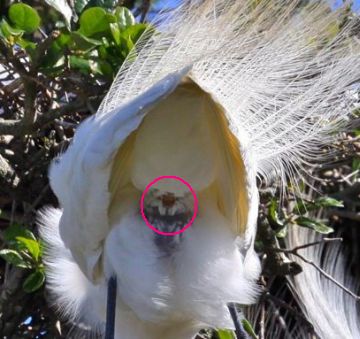 For several weeks we’ve learned about body parts that are the same on birds and humans. Today’s lesson is very different.
For several weeks we’ve learned about body parts that are the same on birds and humans. Today’s lesson is very different.
The cloaca is a bird anatomy part most people never see. It’s under the bird and usually covered by feathers.
Cloaca (pronounced klo-A-ca) is a Latin word that means “to cleanse” and is aptly used to name the bird’s single opening for its urinary, intestinal and reproductive tracts. Here it is on a great egret, circled in pink.
This multi-purpose “vent” may seem odd but male mammals have a single opening for urine and semen. Birds economize further. Everything happens at one location for them.
When birds mate, they touch their cloacas for a few seconds. This brief “cloacal kiss” is just enough time to transfer semen to the female.
If you don’t like the sound of “cloaca” you can use the word “vent,” a prettier, alternative name.
(photo of the underside of a great egret, including cloaca, by Chuck Tague)
Can you please tell me why the Cathedral of Learning webcam isn’t working?
Sorry to leave this here but I didn’t know how else to contact you.
Thanks.
I will leave this message in both places — here and on the next peregrine blog too.
Most webcams have an internal computer that sends the stream to the Internet. The streaming cameras at Gulf and Pitt do not. Both rely on a separate computer to make them work.
Computers sometimes freeze up, sometimes die. At Gulf the computer is in an office so people are there Mon-Fri to restart it if need be. At Pitt, the computer is in a highly secure area. No one goes there and it requires three special keys to get in. For that reason it always takes a long time to arrange a visit to turn that computer back on. (The Gulf camera has the same problems but you don’t see them Mon-Fri because someone is there.)
Because of these problems, webcams in high security areas are not normally set up this way. Instead they have internal computers and can be managed without ever having to visit them. The snapshot camera at Pitt is like that and is capable of streaming — but not to WildEarth.
Thanks very much for the explanation and I’m glad it is back. Seems to me they should start hatching very soon. I did a little research and found that they normally hatch in 33 days. By my calculation, that has passed, for the first egg at least.
And thank you so much for your blog. I like it a lot.
Jane
It’s 33-35 days after incubation begins — which is on the 3rd egg. My bet is April 19 at Pitt but I may be wrong. Peregrines always surprise me.
Regarding the cloaca or vent: what an amazing photo and a part of bird anatomy that I’ve never seen (or knew there was one all-purpose orifice, or knew what it was called : ) The bird anatomy series has been a great learning tool for me, and I’m sure for other bird watchers as well. Thanks.
I don’t want to seem a voyeur, but do peregrines mate in the air? Our mechanic at Kenny Ross in the South Hills told me he had seen them do that. I didn’t question it, since I’m told albatrosses and frigatebirds do. (Of course, they’re over water most of the time! Where else do they have? No private pink room at Niagara Falls, or a staff bathroom in Georgia!), but the observer at the bridge’s comments made me think it was on land.
Just asking!
By the way, one of the other wonders of the ancient world was the sewer system of Rome. It was called the Great Cloaca.
Anne
Can you kindly help me to describe the importance of cloaca in poultry digestion system
Tawen, the cloaca is the end of the digestive system. Here is information on the entire poultry digestive system including the cloaca: http://www.poultryhub.org/physiology/body-systems/digestive-system/